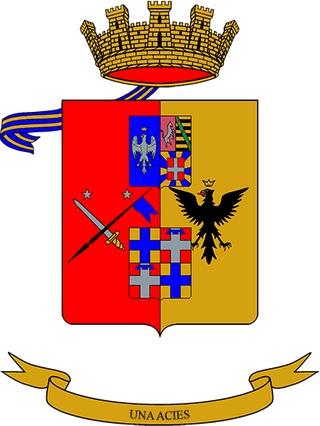Lieutenant general is a military rank used in many countries. The rank originates from the Old European System. The rank traces its origins to the Middle Ages, where the title of lieutenant general was held by the second-in-command on the battlefield, who was normally subordinate to a captain general.

Tor Vergata University of Rome, also known as the University of Tor Vergata, is a public research university located in Rome, Italy. Located in the southeastern suburb of Rome, the university combines a liberal arts tradition with emphasis on career orientation in the field of Economics, Engineering, Mathematics and Physics, Natural Sciences, and Medicine.

A police academy, also known as a law enforcement training center, police college, or police university, is a training school for police cadets, designed to prepare them for the law enforcement agency they will be joining upon graduation, or to otherwise certify an individual as a law enforcement officer, typically a police officer.
Senior captain is a rank which is used in some countries' armed forces, navies, merchant marines, civil aviation and in the airline industry.
An army corps general or corps general is a rank held by a general officer who commands an army corps. The rank originates from the French Revolutionary System, and is used by a number of countries. Normally, the rank is above the divisional general and below the army general, so it usually corresponds to the lieutenant general. However, in some countries such as Spain, Brazil, and Peru, the rank of army corps general is not used, in Spain the rank of army corps general is replaced by the rank of lieutenant general, while in some countries such as Brazil and Peru, the rank of army general is immediately above that of divisional general.

The Polizia Penitenziaria, formally the Corpo di Polizia Penitenziaria, is a law enforcement agency in Italy which is subordinate to the Italian Ministry of Justice and operates the Italian prison system as corrections officers. Vatican City, an independent state, does not have a prison system, so the Vatican sends convicted criminals to the Italian prison system.
The Italian Army ranks are the ranks used by the Italian Army and are worn on epaulettes of shirts. The Army of Italy contains levels of ranks showing both their officers' status and seniority as dedicated members of the Italian militia. Although altered throughout history, the current ranks stand as the lowest rank being "soldato semplice" and the highest rank being "generale". There are a total of 32 ranks in seven categories. These categories include: temporary service volunteers, permanent service volunteers, sergeants, marshals (NCOs), junior officers, senior officers, and generals.
The 1st Carabinieri Paratroopers Regiment "Tuscania" is a special operations unit of the Italian Carabinieri. Together with the 7th Carabinieri Regiment in Laives, the 13th Carabinieri Regiment in Gorizia, and the Special Intervention Group it forms the 2nd Carabinieri Mobile Brigade. The regiment is based in Livorno, and has approximately 550 personnel.

The Military Academy of Modena is a military university in Modena, northern Italy. Located in the Ducal Palace of Modena in the historic center of the city, it was the first such military institution to be created in the world.

The Italian military rank of maresciallo is classified as a "sub-officer" and is the highest rank of non-commissioned officer in the Italian Armed Forces. It is higher than the rank of sergeant but lower than that of ensign/second lieutenant. There are from three to five grades within the rank, according to the different branches of the armed forces. The rank is achieved through merit or attending the Scuola Allievi Marescialli. Marshal is an intermediate rank of the armed forces which is currently granted to NCOs with the training and technical competence to carry out specialised executive roles, and to command smaller and technically complex units.
A new law approved in July 2008 changed the military ranks of Venezuela, principally with regard to names, functions and commanding regulation of the armed forces. The law was sanctioned by Venezuela's National Assembly.
The Ranks of the Italian Air Force are the military rank insignia used by the Italian Air Force, usually worn on jackets and mantels sleeves.
The Military ranks of the Kingdom of Italy were the military insignia used by the Italian Armed Forces when Italy was the Kingdom of Italy (1861–1946). During the World Wars, the Carabinieri, as the then-most senior corps of the Army, wore similar insignia to those used by the rest of the service.

Pierpaolo Sileri is an Italian politician, surgeon and academic professor and since 13 September 2019 Deputy Minister of Health in the government of the Italian Republic.

Brigadier general Ruggiero Capodivento is a member of the Italian Carabinieri, 20th and 26th Commander of the Multinational Specialized Unit, and Commander of the international military mission "MIADIT 16", in Djibouti. He is currently serving as deputy commander of the Carabinieri Legion "Toscana".
Valerio Gildoni was an Italian military officer, colonel of the Carabinieri and a recipient of the gold medal of military valor.
The Police ranks of Italian police officers denote the position of a given officer in the police hierarchy in Italian police forces.
Leandro Verì was an Italian carabiniere.
















































